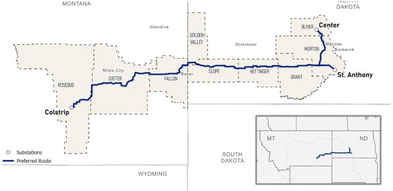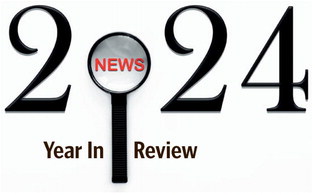Supporters Of Transmission Line Proposed Along Border Says Project Has Huge Implications For Energy Development In Montana, North Dakota


Supporters Of Transmission Line Proposed Along Border Says Project Has Huge Implications For Energy Development In Montana, North Dakota
By Amanda Eggert Montana Free Press
Project developers, policymakers and think tanks working in the capital-intensive arena of energy development say a new Montana-North Dakota high-voltage transmission line could be a game changer for an area of the American West that’s seen limited expansion to its power grid in four decades. The North Plains Connector Line would be the region’s first major grid expansion since the construction of a 500-kilovolt line that carries power from the Colstrip coal-fired power plant to population centers in the Pacific Northwest in the mid-1980s.
Late last year, Minnesota- based energy company ALLETE and Grid United, a Houston-based transmission developer, announced their partnership on a proposal to build a $3.2 billion transmission line from Colstrip to central North Dakota. The companies are billing the roughly 400-mile line as a “long-term energy infrastructure asset” that will help utilities access new regional energy markets, meet rising electricity demand and become more resilient to grid-straining cold snaps and heat waves.
Stakeholders like Kyle Unruh, with renewable energy advocacy organization Renewable Northwest, also describe the North Plains Connector Line as an opportunity for Montana to reap some of the economic benefits accompanying an “explosion” of demand for new power generation — renewable generation in particular. It would do that by allowing a significant amount of electricity to flow between national energy markets.
If built, the North Plains Connector Line will be the first high-capacity transmission line to link the Western Interconnect grid (which operates on alternating current) with the Midcontinent Independent System Operator grid (which uses direct current).
Currently, the western grid is transmission-constrained, challenging utilities that struggle to accommodate rising electricity use and throttling investment in utility-scale energy projects. The North Plains Connector would allow about 3,000 megawatts of additional generation onto the grid.
Grid United plans to submit an environmental impact statement — which will allow the public to review and comment on details of the project proposal — to the U.S. Department of Energy this fall. Brant Johnson, the project’s lead developer for Grid United, said he’s hopeful the review process will conclude within two years. If all goes according to Grid United’s plan, the line could be operational by 2030.
Unruh recently told Montana Free Press there are multiple reasons he’s optimistic the project will be built, even given the notorious difficulties associated with transmission planning and permitting. In his assessment of the project’s prospects, he noted the federal government’s recent move to streamline transmission review and Grid United’s reputation as an “extremely capable” transmission developer with a proactive approach to engaging local communities.
Last month’s announcement that Portland General Electric has inked a deal with Grid United and ALLETE for 20 percent of the line’s capacity, bringing the line’s total subscribed capacity to 55 percent, further improves the project’s prospects by reducing some of the financial risk associated with building it. (ALLETE, which owns two utilities in the upper midwest and a handful of other energy companies, is expected to account for 35 percent of the capacity on the line and oversee its operation.)
During a May 22 presentation before the Montana Legislature’s interim Energy and Telecommunications Committee, Unruh, who formerly worked as a transmission market analyst for North-Western Energy, discussed the economic implications of expanding the grid.
Increasing transmission capacity can help Montana capitalize on its “preeminent wind resource,” entice electricity- intensive businesses to set up shop in (or remain in) Montana, and alleviate the rising power and property tax bills many Montanans are facing, he argued.
On the flip side, Unruh says, Montana’s economy is currently “starting to reap the consequences” of lagging grid expansion as energy developers pursue projects in regions where transmission is currently available or planned.
“Transmission should be at the heart of every economic development discussion we have in the state and every energy discussion we have in the state,” Unruh said.
Tyler Farrell, a transmission researcher with the Rocky Mountain Institute, a nonpartisan think tank focused on decarbonizing the energy sector, said there is a chicken-or-egg dynamic at play in the relationship between electricity generation and transmission.
“If you don’t build the transmission, the generation doesn’t come. If you do build transmission, will the generation come?” he said in a recent interview with MTFP.
Based on his evaluation of maps comparing the location of new energy developments with transmission capacity, Farrell argues that new transmission does beget new energy- generating projects.
Farrell notes that transmission projects are currently garnering significant attention in energy circles because electricity demand is on an upward incline in the West after two decades of extremely limited growth. Building electrification and electric vehicle adoption play a role in that trend, as do grid-straining heat waves and cold snaps and the emergence of industries that require vast amounts of electricity, such as cryptocurrency mining, AI development and cloud computing.
Another dynamic exerting influence is the “greening” of power generation in the United States. Even with the advent of cheaper and longer-lasting utility-scale batteries, the ongoing shift from fossil fuel-based energy generation to renewable resources will require expansions of the existing grid so that solar and wind power can reach electricity users.
Daniel Zolnikov, a Republican state senator from Billings who works as a consultant to energy developers, puts it this way: “If you’re going to have more variable resources, you need a lot of transmission with a lot of different resources all over the place. They won’t be producing all of the time everywhere, but they will be producing all of the time somewhere.”
Zolnikov added that the U.S. is in a “race against time” to build out its grid as legacy fossil fuel power plants drop offline, a trend rooted in both shifting economics and sweeping policy changes.
Farrell, Unruh and others also describe expanded transmission as an asset that can benefit utility ratepayers — even if ratepayers ultimately cover some of cost of the new lines in their monthly bills. If an expanded grid opens utilities’ access to additional power-generation markets, the utilities have more options for obtaining the most affordable power, according to advocates. Farrell argued that the January cold snap that set records for NorthWestern Energy’s electricity load illustrated that opportunity.
“The North Plains Connector would have saved North-Western Energy ratepayers a lot of money by [facilitating access] to low-cost energy from the Dakotas during that period,” Farrell said. “Being able to move that energy into Montana would have really been quite valuable.”
Mike Cashell, vice president of transmission with NorthWestern Energy, which operates most of Montana’s grid and serves the majority of Montana’s power consumers, said the grid “is being pushed to its limits” as more intermittent resources come online. Expanded transmission capacity, he said, will help.
Cashell and others agree that while expanded transmission is needed, it isn’t easy to plan, permit and build new transmission lines. Regional transmission projects involve multiple jurisdictions, resource considerations (e.g., sage grouse habitat) and complicated negotiations about who should pay for new lines, which often cost billions of dollars to build and confer a variety of economic, tax and grid-resilience benefits to different entities.
Permitting and payment allocation complications led NorthWestern to shelve the Mountain States Transmission Intertie, a controversial new line it had planned between Townsend, Mont., and Jerome, Idaho, in 2012 after it had already invested $24 million in project planning. MSTI encountered opposition from county commissioners who felt excluded from the planning process and landowners unhappy about the prospect of becoming unwilling hosts of industrial-scale energy infrastructure. NorthWestern’s anticipated use of eminent domain, which allows the government to condemn private property for “public use” so long as landowners are provided “just compensation,” proved a major source of friction for MSTI.
Since the North Plains Connector route has yet to be finalized, it’s too soon to tell if similar landowner- and local government-related headwinds are in store for Grid United.
Cashell told MTFP that proposed changes to encourage a more proactive approach to transmission planning might lessen some of the obstacles his company encountered with MSTI. He said the Federal Energy Regulatory Commission’s recent rule directing regional grid operators like NorthWestern Energy to document transmission constraints and opportunities every five years should help advance the conversation, as will utilities’ participation in a voluntary initiative called the Western Transmission Expansion Coalition, which has been tasked with developing “an actionable transmission plan to support the needs of the future energy grid.”
Cashell said NorthWestern has been in talks with Grid United and ALLETE about the North Plains Connector, but has yet to make a decision about signing on to the project. (Several utilities are anticipated to purchase a share of the line’s capacity, as is the case with the 500-kilovolt line leading west out of Colstrip.)
“Like any of these regional transmission offerings and potentials, we’re keeping eyes on it,” he said. “It is a big, big lift.”
For his part, Unruh, with Renewable Northwest, said he’s hopeful the North Plains Connector can show that it’s possible to build new regional transmission lines in the space of years rather than decades.
“We’re hoping that North Plains Connector can demonstrate it doesn’t have to take forever,” he said. “Economic development, economy security, energy security — it all comes through transmission security.”



